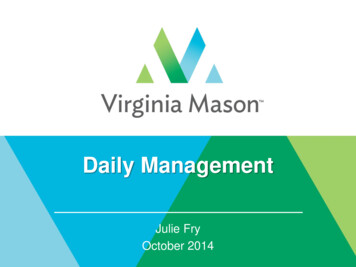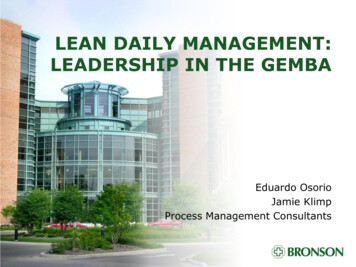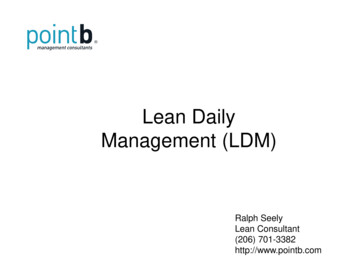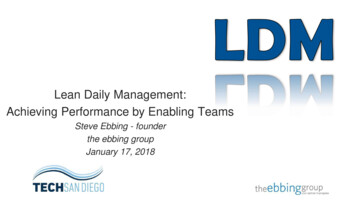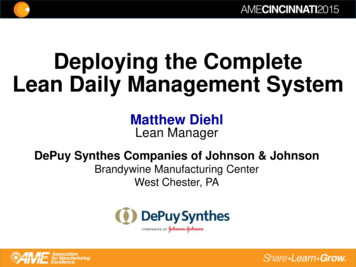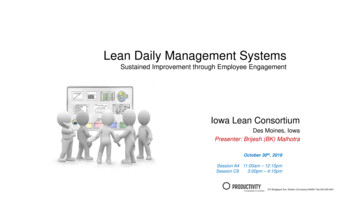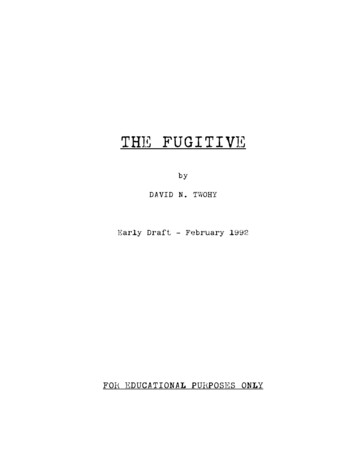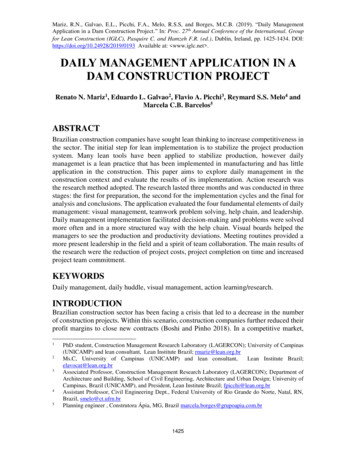
Transcription
Mariz, R.N., Galvao, E.L., Picchi, F.A., Melo, R.S.S, and Borges, M.C.B. (2019). “Daily ManagementApplication in a Dam Construction Project.” In: Proc. 27th Annual Conference of the International. Groupfor Lean Construction (IGLC), Pasquire C. and Hamzeh F.R. (ed.), Dublin, Ireland, pp. 1425-1434. DOI:https://doi.org/10.24928/2019/0193 Available at: www.iglc.net .DAILY MANAGEMENT APPLICATION IN ADAM CONSTRUCTION PROJECTRenato N. Mariz1, Eduardo L. Galvao2, Flavio A. Picchi3, Reymard S.S. Melo4 andMarcela C.B. Barcelos5ABSTRACTBrazilian construction companies have sought lean thinking to increase competitiveness inthe sector. The initial step for lean implementation is to stabilize the project productionsystem. Many lean tools have been applied to stabilize production, however dailymanagemet is a lean practice that has been implemented in manufacturing and has littleapplication in the construction. This paper aims to explore daily management in theconstruction context and evaluate the results of its implementation. Action research wasthe research method adopted. The research lasted three months and was conducted in threestages: the first for preparation, the second for the implementation cycles and the final foranalysis and conclusions. The application evaluated the four fundamental elements of dailymanagement: visual management, teamwork problem solving, help chain, and leadership.Daily management implementation facilitated decision-making and problems were solvedmore often and in a more structured way with the help chain. Visual boards helped themanagers to see the production and productivity deviations. Meeting routines provided amore present leadership in the field and a spirit of team collaboration. The main results ofthe research were the reduction of project costs, project completion on time and increasedproject team commitment.KEYWORDSDaily management, daily huddle, visual management, action learning/research.INTRODUCTIONBrazilian construction sector has been facing a crisis that led to a decrease in the numberof construction projects. Within this scenario, construction companies further reduced theirprofit margins to close new contracts (Boshi and Pinho 2018). In a competitive market,12345PhD student, Construction Management Research Laboratory (LAGERCON); University of Campinas(UNICAMP) and lean consultant, Lean Institute Brazil; rmariz@lean.org.brMs.C, University of Campinas (UNICAMP) and lean consultant,Lean Institute Brazil;elavocat@lean.org.brAssociated Professor, Construction Management Research Laboratory (LAGERCON); Department ofArchitecture and Building, School of Civil Engineering, Architecture and Urban Design; University ofCampinas, Brazil (UNICAMP), and President, Lean Institute Brazil; fpicchi@lean.org.brAssistant Professor, Civil Engineering Dept., Federal University of Rio Grande do Norte, Natal, RN,Brazil, smelo@ct.ufrn.brPlanning engineer , Construtora Ápia, MG, Brazil marcela.borges@grupoapia.com.br1425
Mariz, R.N., Galvao, E.L., Picchi, F.A., Melo, R.S.S, and Borges, M.C.Bconstruction companies have sought ways to reduce their costs, such as investments intechnologies, building systems and management methods (Tiwari et al. 2018).Lean Thinking has been an alternative used to increase the competitiveness ofcompanies due to the fact that it is based on eliminating waste along the value stream,thereby shortening lead times, reducing costs and also increasing product quality.(Womack and Jones 2003).A basic premise for implementing lean is to achieve basic process stability (Ohno 1997).Some tools have been used to achieve basic stability in the construction environment, suchas: value stream mapping (VSM), workplace organization (5S Method), Total ProductiveMaintenance (TPM), Last Planner System and Kanban (Gallardo et al. 2014).Daily management is a lean practice widely used in manufacturing sector to removeprocess instability (Liker and Hoseus 2008). In the construction sector there is still noconsolidated application of this practice. Therefore, this paper aims to explore the dailymanagement in the construction context and evaluate the results of its implementation.DAILY MANAGEMENTDaily management (DM) is a continuous process that ensures that work is done in theright way and in the right time, in order to achieve business success according to thecompany’s strategic objectives (Ferro and Gouveia, 2015). The Daily Managementelements are (Liker and Hoseus 2008; Ferro and Gouveia 2015): Visual management: Visualization must be simple in order to ensure clarityand focus, and to allow everybody to understand. A simple board is used to expose targetsand problems Teamwork problem solving: It’s necessary to create an environment in whichhiding problems is neither acceptable nor possible. The right way to work, which leanthinking advocates for, is exposing problems, effectively solving them, and asking for help.Just having the numbers exposed is not enough: daily management encourages (and, really,calls for) teamwork and cooperation. The team should always engage in open discussionsto understand the situation, do some analysis on the spot, and decide what actions areneeded in the event of a gap between current and expected performance. Help chain: Essentially, the help chain turns the traditional organizationalpyramid upside down, which allows the organization to move away from a command-andcontrol attitude and towards a culture in which all necessary support is given to theprocesses of value creation and problem solving Leadership: Just having the standup meetings is not sufficient. Leadershipshould be involved every step of the way. They must be capable of keeping the meetingsfocused and all team members involved. The meeting routines generate great opportunitiesto develop the employees’ capabilities and change they way people tackle problems andwork in teams.The Last Planner System added the daily huddle in an update made by Ballard (2003),but has not been universally practiced (Ballard et al. 2009; Daniel et al., 2015).Daily huddle focuses on achieving weekly planning for daily control through quickmeetings with team members (Ballard et al. 2009). Daily management focuses on solving1426Proceedings IGLC – 27, July 2019, Dublin, Ireland
Daily Management Application in a Dam Construction Projectproblems through a structured help chain with active leadership participation as a way todevelop the team (Ferro and Gouveia. 2015).RESEARCH METHODThe research strategy adopted was action research, which according to Thiollent (2007) isa type of empirical social research that is conceived and carried out in close associationwith an action or with the resolution of a collective problem and in which researchers andrepresentatives of the situation or problem are involved in a cooperative or participatorymanner.The research was divided into 3 stages. In the first stage a preparation was carried outto understand the main problems of the project and to align the scope of the research. Inthe second stage, 3 learning cycles were carried out for three months (1 month per cycle),where one week a month practical workshops were held in the field with significantcollaboration between the researchers and the project team.In cycle 1 the meeting routines (with the supervisors and their teams) and the visualmanagement were created and implemented. During cycle 2 the meeting routines with theengineers and managers were implemented. The last cycle served to improve the routines,and visual management.In the third stage a final reflection was made aiming at consolidating this practice in thecompany and expanding to other projects of the construction company (Figure 1).Figure 1: Research DesignThe construction company in which this study was developed has almost 60 years ofexperience in the market and predominantly works with infrastructure projects: paving,dams, drainage, railway, bridges and tunnels.The pilot project that was chosen by the company was the raising a tailings dam fromthe 229.60m quota to the 245.00m quota. This project was divided basically on two tasks:1427Paper not Presented
Mariz, R.N., Galvao, E.L., Picchi, F.A., Melo, R.S.S, and Borges, M.C.BA.B.Materials Sieving Process: part of the material that was released in the damwas sieved to be later taken to the dam, that is, a task was focused in thesieving process (Thick Shale, Fine Shale and Quartz);Dam: Another task was located at the launch of the processed andunprocessed material (clay and filter).Figure 2: Dam Construction SiteRESULTS AND DISCUSSIONThe discussion and presentation of the results was divided by the elements of dailymanagement, as follows:VISUAL MANAGEMENTSite observations were performed in order to identify some waste. These observationshelped the project team to identify that the production process of the tasks (MaterialsSieving Process and Dam) was very unstable. At the end of the first week a lecture wasgiven on Daily Management with the lean committee (site manager, planning engineer andlean coodinator). Then, a visual management board (first version) was drawn for theMaterials Processing task.Based on what was already usual and also aligned with the field language, it wasdecided to use the unit to measure production as "trips" and to measure "trips / trucks"productivity. Finally, a meeting was held with those in charge of the Materials Processingtask to explain the new practice, to define schedules and participants in the meeting (Figure3).1428Proceedings IGLC – 27, July 2019, Dublin, Ireland
Daily Management Application in a Dam Construction ProjectFigure 3: Presentation meeting of the first version of the Daily Management BoardDaily meetings were implemented and consolidated in Materials Sieving Process taskin 2 weeks (Figure 4). Supervisors showed resistance to change in the beginning. However,once meeting routine was established they perceived its benefits. Then, daily managementwas also incorporated in Dam task with some adaptations in the board.Figure 4: Daily meeting in the dam taskVisual management helped to expose the problems and especially the practicalunderstanding of the concept of production and productivity. Before daily managementapplication, only production was controlled, that is, no matter how many trucks, the goalwas always to beat the daily goal of trips.After the visual management board and the routine of meetings were implemented, theteam members began to optimize the use of trucks, including a few times a day to stoptrucks from queuing in the cycle when there was a change of schedule.It is important to note that the trucks were rented and paid per hour used, therefore whenqueuing occurred in a given cycle and they were connected they would have the cost ofrent and diesel.1429Paper not Presented
Mariz, R.N., Galvao, E.L., Picchi, F.A., Melo, R.S.S, and Borges, M.C.BTEAMWORK PROBLEM SOLVINGTeam involvement was a key factor in deploying daily management. Many problemswere reported with the daily meeting routine implemented. Simple problems were solvedwith immediate team action and larger problems needed further analysis with theengineering team. During the first month some recurring problems were identified. Themost recurring problem for material sieving process was the instabilities in the truck cycles,while for the dam task was the number of trucks above planned.Problems were understoodin their root causes with the help of the engineering team. It was identified that the constantchange in the location from which the processed material would be withdrawn andtransported to the dam caused problems in production in relation to the amount of trucksand machines that would be used to do this task.Some truck queues could be seen when walking by the field. Every day the client gaveinformation shortly before starting the working day or other times after starting from whichstock should be removed the material to be released to the dam. The change was due to thefact that an inventory of benefited material could only be released to be transported once itwas fully stocked and the topography team raised its volume.The team then proposed as a countermeasure the creation of a worksheet that mappedall the possible scenarios and that could absorb the daily changes made by the client.Therefore, all inventories and ATDs (Average Transport Distance) were obtained withrevised and timed data in gemba.This worksheet has been distributed to all team members. Then, they started to havemore autonomy in the field and also started to control the correct amount of trucks. A visualboard was also created as a way to identify daily from where the materials were beingremoved (Figure 5).Figure 5: Visual Control of inventories, trucks and machinesHELP CHAINThe help chain worked informally, that is, actions were taken on some problems that camefrom the field, however there was no priority, control or follow-up actions. The contractmanager and planning engineer himself missed some of the field information more often.Then, in the second month when the daily field meetings were already going as planned,the engineering team decided to hold a quick meeting (15-30min) at 11:30 a.m. so that they1430Proceedings IGLC – 27, July 2019, Dublin, Ireland
Daily Management Application in a Dam Construction Projectcould align the field information daily, discussing them, generating actions and monitoringthem.Some problems that were staggered from the field meeting to the engineering meetingwere already solved by immediate action, while other actions would require visualmanagement for follow-up, so the team deployed a “Kanban” board (Figure 4). Therefore,a structured help chain with field and engineering participation was established (Figure 6):TO DODOINGDONEFigure 6: Engineering daily management utilizing the “Kanban” boardFigure 7: Help ChainLEADERSHIPThe role of leadership was fundamental in implementing daily management. The changeof mindset in particular from the engineering team was felt by the project team. Theplanning engineer and the project manager who did not go often to gemba started to gofrequently, since a rotation of participation in the meetings involving (project manager,lean manager and planning engineer) was established, therefore, at least 3 times per week1431Paper not Presented
Mariz, R.N., Galvao, E.L., Picchi, F.A., Melo, R.S.S, and Borges, M.C.Bthey attended the daily meeting in the field, in addition to attending the engineering meetingevery day.As time went by, the team members brought more problems and more activelyparticipated in the meetings. They reported the importance of the presence of the engineersand especially of the actions that were taken at the meetings with their help.GENERAL RESULTSThe last project had cost overruns of 30% leading the company to implement theaforementioned lean practices to make a turnaround in this scenario. After the end of theproject, some data were collected and the cost reduction became evident: Materials Processing task - 4% reduction in cost (US 71.200,00) Dam task - 7% reduction in cost (US 535.000,00)This result came especially from the reduction of the planned quantity of trucks(representing 70% of the project cost) and the best use of the trucks that were available.Transparency through visual management was also positive for the team. This madethe data simple and easy to be controled by the team members.Furthermore, the project was completed within planned schedule and it was noticed thechange of behavior of the managers and engineers who focused not only on production butalso on productivity. Such a concept helped to always be aware of the waste and dailyproblems.CONCLUSIONDaily management implementation enabled the team to identify deviations daily inproduction, causing them to take immediate action to correct them.Visual management helped to clarify the production and productivity goals of the damand materials processing tasks team. The information on the board served as the meeting'snorth, including to point out deviations.Team involvement in problem solving made it easier to identify problems and takeaction. Team involvement also helped to improve the sizing of the truck cycle.Help chain alongside with field meetings and engineering team meetings helped tosolve more complex problems, as engineering team began to make decisions based on theinformation that came from the field every day, including monitoring the actions thatshould be taken.Leadership has become more present and participatory in gemba. The field team's ownperception of the actual presence of engineering team was noted as positive.Benefits generated by the daily management implementation went beyond thequantitative sphere (cost and time) and were also qualitative (increased transparency andbehavior change).Daily support of these practices helps the company stabilize its processes and alsopromote improvements. The daily management was considered a fundamental practice for1432Proceedings IGLC – 27, July 2019, Dublin, Ireland
Daily Management Application in a Dam Construction Projectthe construction company that will take advantage of the learning of this project to expandthis practice to other projects of the company.Future research might explore daily management system in other company departments(supply, work safety, and quality). A further study could involve the top management levelon daily problem solving.AKNOWLEDGEMENTSAuthors would like to thank CAPES for funding part of the study.REFERENCESBallard, G. and Howell,G.A,. (2003). An Update on Last Planner. In: Proc. 11th Ann. Conf.of the Int’l. Group for Lean Construction. Virginia.Ballard, G., Hammond, J. and Nickerson, R. (2009). Production Control Principles.In:, Proc 17th Ann. Conf. of the Int’l. Group for Lean Construction. Taipei, Taiwan, pp489-500.Boshi, R., and Pinho,C. (2018).” Crisis and austerity: the recent trajectory of capitalistdevelopment in Brazil.” Contemporary Politics.,28(1-22).Daniel, E.I., Pasquire, C. and Dickens, G., (2015). Exploring the implementation of theLast Planner System through IGLC community: twenty one years of experience. In:Proc. 23rd Ann. Conf. of the Int’l. Group for Lean Construction. Perth, AustraliaFerro, J., and Gouveia,R. (2015). How to create an effective daily management system.Planet Lean.Gallardo, C., Granja., A., and Picchi,F. (2014). “Productivity Gains in a Line Flow PrecastConcrete Process after a Basic Stability Effort”. ASCE, J. Constr. Eng. Manage., 140(4).Liker, J.K. and Hoseus, M. (2008). Toyota Culture McGraw-Hill: New York, NY. 562ppOhno, T. (1988) Toyota Production System; Beyond large scale production,Productivity Press, Portland, Oregon.Thiollent, M. (2011): Action Research Methodology. 18.ed. São Paulo: Cortez, 2011.Tiwari,S., Chan, S., and Mubarak,M. (2018). Critical analysis of procurement techniquesin construction management sectors. IOP Conf. Series: Materials Science andEngineering 342.Womack, J.P., and Jones, D.T (2003) Lean Thinking. Revised and updated. Free Press.1433Paper not Presented
Mariz, R.N., Galvao, E.L., Picchi, F.A., Melo, R.S.S, and Borges, M.C.B1434Proceedings IGLC – 27, July 2019, Dublin, Ireland
system. Many lean tools have been applied to stabilize production, however daily managemet is a lean practice that has been implemented in manufacturing and has little . Daily management is a lean practice widely used in manufacturing sector to remove process instability (Liker and H
